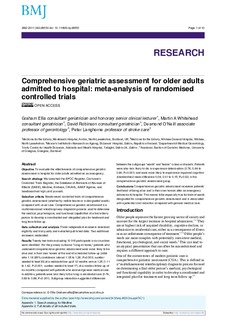| dc.contributor.author | Ellis, G. | |
| dc.contributor.author | Whitehead, M.A. | |
| dc.contributor.author | Robinson, D. | |
| dc.contributor.author | O’Neill, D. | |
| dc.contributor.author | Langhorne, P. | |
| dc.date.accessioned | 2018-02-19T14:33:52Z | |
| dc.date.available | 2018-02-19T14:33:52Z | |
| dc.date.issued | 2011 | |
| dc.identifier.citation | Ellis, G., Whitehead, M. A., Robinson, D., O’Neill, D. & Langhorne, P. (2011). Comprehensive geriatric assessment for older adults admitted to hospital: Metaanalysis of randomised controlled trials. BMJ, 343. | nb_NO |
| dc.identifier.uri | http://hdl.handle.net/11250/2485753 | |
| dc.description.abstract | Objective: To evaluate the effectiveness of comprehensive geriatric assessment in hospital for older adults admitted as an emergency.
Search strategy: We searched the EPOC Register, Cochrane’s Controlled Trials Register, the Database of Abstracts of Reviews of Effects (DARE), Medline, Embase, CINAHL, AARP Ageline, and handsearched high yield journals.
Selection criteria: Randomised controlled trials of comprehensive geriatric assessment (whether by mobile teams or in designated wards) compared with usual care. Comprehensive geriatric assessment is a multidimensional interdisciplinary diagnostic process used to determine the medical, psychological, and functional capabilities of a frail elderly person to develop a coordinated and integrated plan for treatment and long term follow-up.
Data collection and analysis: Three independent reviewers assessed eligibility and trial quality and extracted published data. Two additional reviewers moderated.
Results: Twenty two trials evaluating 10 315 participants in six countries were identified. For the primary outcome “living at home,” patients who underwent comprehensive geriatric assessment were more likely to be alive and in their own homes at the end of scheduled follow-up (odds ratio 1.16 (95% confidence interval 1.05 to 1.28; P=0.003; number needed to treat 33) at a median follow-up of 12 months versus 1.25 (1.11 to 1.42; P<0.001; number needed to treat 17) at a median follow-up of six months) compared with patients who received general medical care. In addition, patients were less likely to be living in residential care (0.78, 0.69 to 0.88; P<0.001). Subgroup interaction suggested differences between the subgroups “wards” and “teams” in favour of wards. Patients were also less likely to die or experience deterioration (0.76, 0.64 to 0.90; P=0.001) and were more likely to experience improved cognition (standardised mean difference 0.08, 0.01 to 0.15; P=0.02) in the comprehensive geriatric assessment group.
Conclusions: Comprehensive geriatric assessment increases patients’ likelihood of being alive and in their own homes after an emergency admission to hospital. This seems to be especially true for trials of wards designated for comprehensive geriatric assessment and is associated with a potential cost reduction compared with general medical care. | nb_NO |
| dc.publisher | BMJ | nb_NO |
| dc.rights | Navngivelse-Ikkekommersiell 4.0 Internasjonal | * |
| dc.rights.uri | http://creativecommons.org/licenses/by-nc/4.0/deed.no | * |
| dc.subject | Comprehensive Geriatric Assessment | nb_NO |
| dc.subject | older adults | nb_NO |
| dc.subject | randomised controlled trials | nb_NO |
| dc.subject | pasientforløp | nb_NO |
| dc.title | Comprehensive geriatric assessment for older adults admitted to hospital: Metaanalysis of randomised controlled trials | nb_NO |
| dc.type | Journal article | nb_NO |
| dc.source.volume | 343 | nb_NO |
| dc.source.journal | BMJ | nb_NO |
| dc.identifier.doi | 10.1136/bmj.d6553 | |

